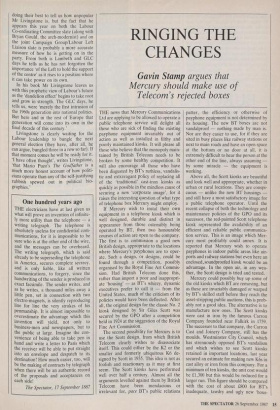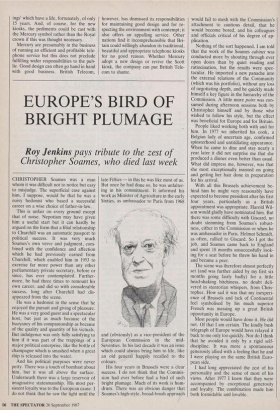RINGING THE CHANGES
Gavin Stamp argues that
Mercury should make use of Telecom's rejected boxes
THE news that Mercury Communications Ltd are applying to be allowed to operate a public telephone service will delight all those who are sick of finding the existing payphone equipment invariably out of action as well as installed in filthy and poorly maintained kiosks. It will please all those who believe that the monopoly main- tained by British Telecom needs to be broken by some healthy competition. It will also encourage all those who have been disgusted by BT's ruthless, vandalis- tic and extravagant policy of replacing all of the 'traditional' cast-iron kiosks as quickly as possible in the mindless cause of securing a new 'corporate image', for it raises the interesting question of what type of telephone box Mercury might employ.
If Mercury wish to instal their own equipment in a telephone kiosk which is well designed, durable and distinct in appearance from those ostensibly being operated by BT, then two honourable courses of action are open to the company. The first is to commission a good new British design, appropriate to the locations where Mercury's payphones are to oper- ate. Such a design, or designs, could be found through a competition, possibly organised by the Royal Fine Art Commis- sion. Had British Telecom done this, rather than import a poor and inappropri- ate 'housing' — as BT's whizzy, dynamic executives prefer to call it — from the United States, much of the criticism of its policies would have been deflected. After all, the original design for the classic No. 2 kiosk designed by Sir Giles Scott was secured by the GPO after a competition held in 1924 at the suggestion of the Royal Fine Art Commission.
The second possibility for Mercury is to use the Scott design, from which British Telecom clearly wishes to disassociate itself. This could either be the K2 or the smaller and formerly ubiquitous K6 de- signed by Scott in 1935. This idea is not as foolish and reactionary as it may at first seem. The Scott kiosks have performed well over half a century. Almost all the arguments levelled against them by British Telecom have been mendacious or irrelevant for, pace BT's public relations
patter, the efficiency or otherwise of payphone equipment is not determined by its housing. The new BT boxes are not vandalproof — nothing made by man is. Nor are they easier to use, for if they are sited in busy places like railway stations or next to main roads and have an open space at the bottom or no door at all, it is extremely difficult to hear the person at the other end of the line, always assuming by some miracle — the equipment is working.
Above all, the Scott kiosks are beautiful and look well and appropriate, whether in urban or rural locations. They are conspi- cuous — unlike the new BT housings and still have a most satisfactory image for a public telephone operator. Until the recent collapse of both the technology and maintenance policies of the GPO and its successor, the red-painted Scott telephone kiosk represented the availability of an efficient and reliable public communica- tion service. This is an image which Mer- cury most profitably could annex. It is reported that Mercury wish to operate payphones in indoor public areas like air- ports and railway stations but even here an enclosed, soundproofed kiosk would be an advantage. In the open air, in any wea- ther, the Scott design is tried and tested.
Mercury could possibly buy up some of the old kiosks which BT are removing, but as these are invariably damaged or warped by BT's skilled staff before they reach the asset-stripping public auctions, this is prob- ably not a good idea. The alternative is to manufacture new ones. The Scott kiosks were cast in iron by the famous Carron Company founded near Falkirk in 1759. The successor to that company, the Carron Cast and Joinery Company, still has the moulds. Westminster City Council, which has strenuously opposed BT's vandalism and which wishes to see Scott kiosks retained in important locations, last year secured an estimate for making new K6s in cast alloy or iron from this company. For a minimum of ten kiosks, the unit cost would be £1,300 but this would be reduced for a larger run. This figure should be compared with the cost of about £800 for BT's inadequate, tawdry and ugly new `hous- ings' which have a life, fortunately, of only 15 years. And, of course, for the new kiosks, the pediments could be cast with the Mercury symbol rather than the Royal crown if this was thought necessary.
Mercury are presumably in the business of running an efficient and profitable tele- phone service but this does not preclude fulfilling wider responsibilities to the pub- lic. Good design can often go hand in hand with good business. British Telecom, however, has dismissed its responsibilities for maintaining good design and for re- specting the environment with contempt; it also offers an appalling service. Other nations find it incomprehensible that Bri- tain could willingly abandon its traditional, beautiful and appropriate telephone kiosks for no good reason. Whether Mercury adopt a new design or revive the Scott kiosk, the company can put British Tele- com to shame.































































 Previous page
Previous page